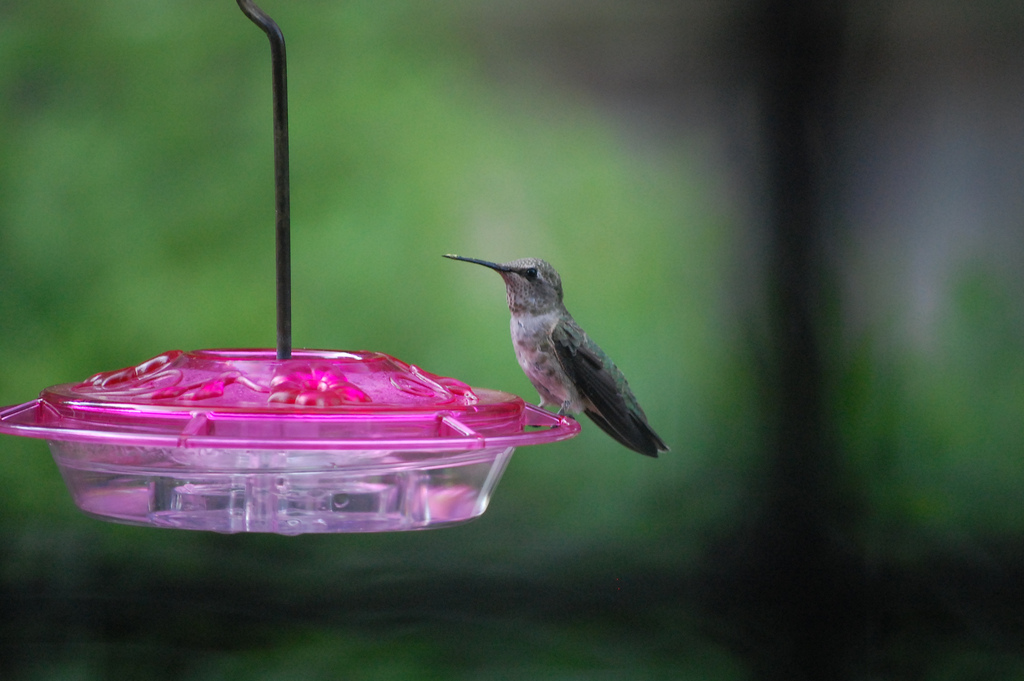More Ideas How To Keep Hummingbird Feeders From Freezing
It has been really cold at nights with temperatures below freezing for the past several days in my garden, and I have noticed quite a few people looking for information on keeping hummingbird nectar from freezing. So I did a little research and came up with several more ideas how to keep hummingbird feeders from freezing.
Most people know that black or dark colors absorb heat, but did you know that not all dark colors absorb the same amount of heat. Black absorbs the most and blue is good too. (Have you ever used a sun shower camping? Those black rubber bags really heat up the water.) There are even some hummingbird feeders that are blue. But red which is great to attract hummingbirds in the summer, might not be so good in the winter. Red will not absorb heat, it actually reflects the red rays of light. That is why we see the color red. So, you may want to select a dark color, other than red to put your hummingbird nectar in for the winter.
Similarly, try using a dark colored feeder protector above your hummingbird feeder, particularly one of the black umbrella shaped ones. The black feeder protector will heat the air under the umbrella and may keep your feeder just a little warmer. It is worth a try.
You may or may not know that using a stronger dilution of sugar to water in homemade hummingbird nectar decreases the temperature at which the mixture freezes. For instance a 1:4 dilution freezes at around 27-28 degrees while a 1:3 dilution freezes at around 25-26 degrees. But is it safe for the hummingbirds?
The information I found was mixed. The objective of making your own hummingbird nectar is to duplicate nature as much as possible and the natural sugar concentration of nectar from flowers. This varies quite a bit. My impression is that a concentration in the range of natural flower nectar would be safe. But what were the actual recommendations from reputable sources?
. The Migratory Bird Center of the Smithsonian notes that natural nectars vary widely in sugar concentrations vary widely. And the average natural sugar composition in flower nectar is 26% (which would translate into about a 1:3 dilution. However their actual recipe for hummingbird nectar was 1:4.
. The Audubon Society cautions Against high dilutions of sugar to water, because of risk of kidney or liver damage at high concentrations. They firmly recommend a 1:4 dilution. When I questioned someone there, they held firm to a 1:4 dilution.
. Oregon State University Extension services recommends a 1:4 dilution, but I could not find any cautions. When speaking with one of the Master Gardeners, he confirmed the recommendation for a 1:4 dilution. However, he thought that the question was interesting given the range natural sugar concentrations of nectar from flowers and might be worthy of further exploration.
. And the Southeastern Arizona Bird Observatory recommends a range of dilutions between 1:3 to 1:5. They do caution against a dilution stronger than 1:3.
The conclusion is that, while it appears to be safe to use the stronger 1:3 dilution, given the range of natural nectar sugar concentration averages about 1:3, the Audubon Society and Oregon State University Extension Service recommend a 1:4 dilution. The better path would be to confirm with your local Extension Service that the 1:3 dilution is indeed safe. I have further noted what I found out when speaking to those sources directly. Your local Extension may have access to additional information.
There you have it, a just few more ideas for keeping your hummingbirds fed in your garden this winter. I know that I plan to add these to my repertoire for keeping my hummingbirds fed in winter.



Hi there just wanted to let you know that a stonger solution will hurt the hummingbirds. I use disposable handwormers to keep the feeders from freezing. I love our hummingbirds & don’t want them to suffer.
LikeLike
Hi Liz, I think we are all concerned about the welfare of our beautiful little hummers. I have posted a little more about the range of natural range of flower nectar concentrations as well as some more recommendations from reputable sources. Even though the 1:3 concentration appears would fall within the range that natural nectar would be in, caution is called for until it could be confirmed that it is safe.
Yael
LikeLike
I don’t think I have to worry about it where I live, (Alberta, Canada) as the hummingbirds are long gone before our winter sets in, as our temperatures get down to -40 Celsius, so there’s nothing to feed!
Roll on spring….
~Bruce
LikeLike
Bruce,
That is pretty cold. I think -40C is about where the Celsius and Farenheit scales meet (-38 degrees) Brrr! No, I don’t think you will have to worry about hummingbird feeders.
Looking forward to spring!
Yael
LikeLike